You’ll find towering red sandstone walls, ancient ruins, and living Navajo communities in a place that feels both timeless and immediate. This guide will help you get there, pick the best overlooks and tours, and navigate permits and cultural expectations so your visit is smooth and respectful. Keep going to plan a one-day itinerary, transportation options, and practical tips that make the most of your time at Canyon de Chelly.
Getting to Canyon De Chelly
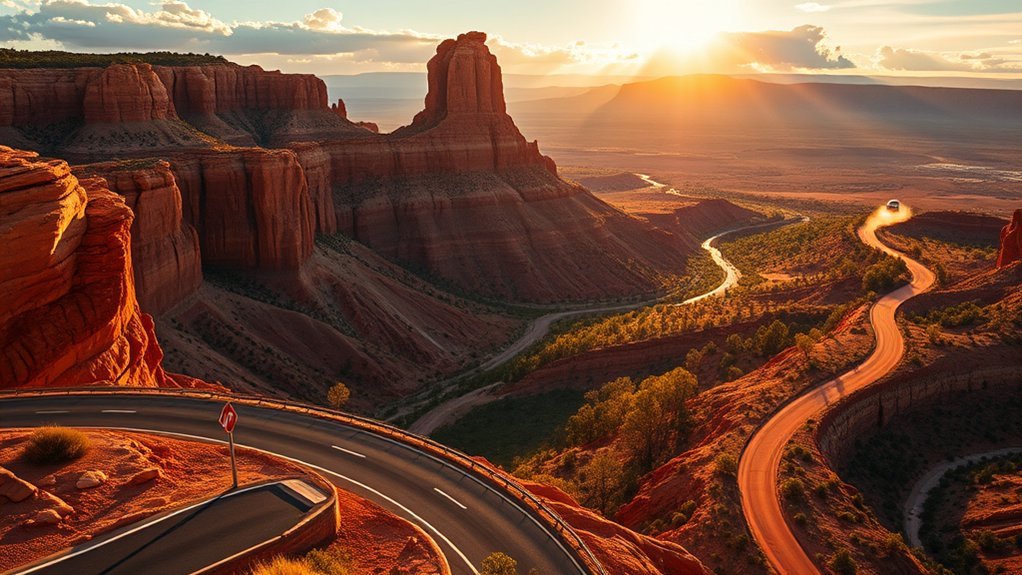
To reach Canyon de Chelly, take exit 333 from I‑40 and head north on US‑191 toward Ganado, then continue about 30 miles to the roundabout where you’ll take the first exit onto Indian Route 7 into Chinle. Follow the second exit at the next roundabout to stay on Indian Route 7 until you enter Canyon de Chelly National Monument. The park entrance and Welcome Center sit less than three miles from Highway 191, so you’ll arrive quickly once you’re on the Indian Route. Clear signage guides your navigation, and parking is available at overlooks and the visitor center. Remember to fill your tank beforehand: gas stations and services are limited nearby, so plan accordingly for a smooth visit.
Park Hours, Seasons, and Weather
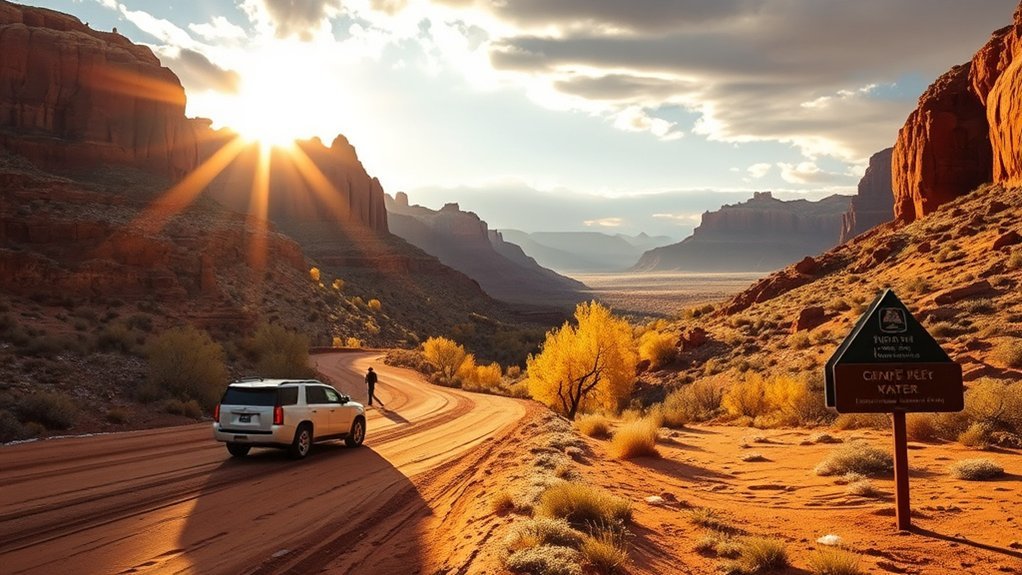
Canyon de Chelly is open year-round from 8:30 a.m. to 4:30 p.m., so you can plan a visit any season but should be mindful of changing conditions. Summer (June–August) offers the warmest weather and the most canyon tour options, while May and September give you milder temperatures and October can bring a sharp drop to highs near 40°F. There are no vendors in the park, so bring water and layered clothing to match the typical seasonal swings.
Operating Hours Year-Round
The park is open year‑round from 8:30 a.m. to 4:30 p.m., so you can plan visits any season and still access the overlooks, trails, and interpretation at consistent hours. Canyon de Chelly National Monument staff maintain the entrance and Welcome Center during those operating hours to help visitors with maps, permits, and safety information. You’ll want to arrive early to maximize daylight for overlooks and ranger contacts; guided tours also follow those same daily windows. There are no on-site vendors, so pack refreshments and enough water for your party before you enter. Weather changes quickly outside the Visitor Center, so check conditions on arrival and let staff know your plans. Respect posted closures and Navajo-run tour rules for a safe visit.
Best Seasons to Visit
Although the monument’s gates are open year‑round from 8:30 a.m. to 4:30 p.m., the best seasons for canyon visits depend on what you want to do: summer (June–August) brings warm, dry days and is ideal for group tours, while May and September offer similar warmth without the peak heat; spring and fall provide the most comfortable conditions overall, and winter brings much cooler temperatures—average highs drop toward 40°F in January—so plan clothing and timing accordingly. You’ll find Canyon de Chelly rewarding nearly any time, but the best time to visit for tours and photography is early morning or late afternoon when light flatters the walls. Pack plenty of refreshments, check daily temperatures, and expect wide swings between daytime heat and cooler evenings.
Typical Weather Patterns
Because weather shapes every visit, plan your trip around park hours (8:30 a.m.–4:30 p.m.) and seasonal conditions so you get the experience you want. At Canyon de Chelly you’ll find distinct patterns: summer brings high temperatures near 90°F, so tours are busiest then; May and September are ideal months for milder heat; October drops toward 40°F, prompting cooler weather gear. Pack plenty of refreshments—no vendors operate inside the park—so you stay safe and comfortable.
- Summer: warm days, popular with visitors, busy trails.
- May & September: ideal months, moderate temperatures, fewer crowds.
- October: cooler weather, bundle up for chilly highs.
- Year-round access: use daylight hours for safe exploration.
One-Day Itinerary and Scenic Rim Drives
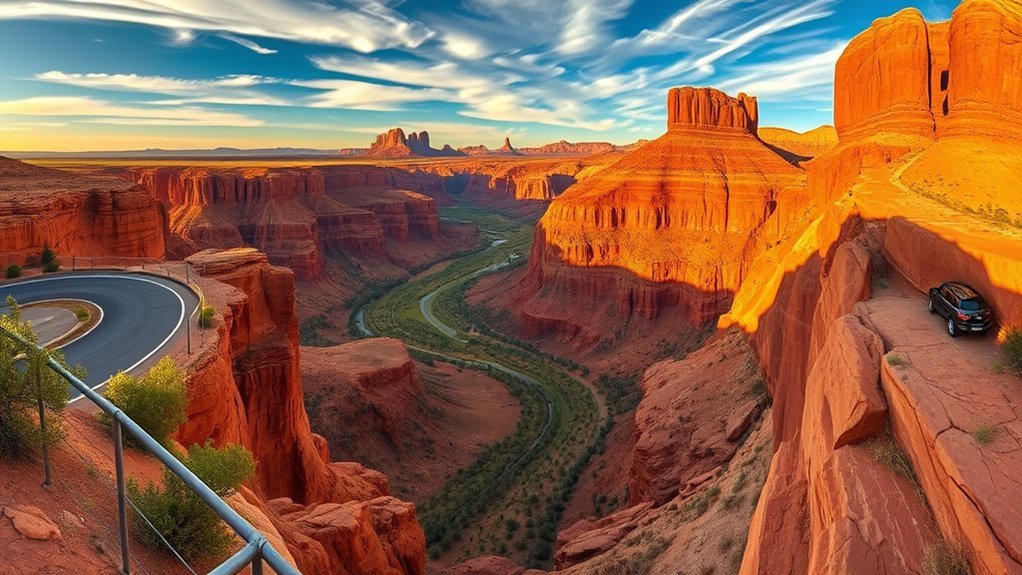
Start your day on the North Rim for sunrise at overlooks like Fortress and Antelope House to see cliff dwellings and wide desert vistas. Mid-morning, join an authorized Navajo guide for a roughly four-hour canyon-bottom tour (fees vary), then spend your evening driving the South Rim to catch Spider Rock glowing at sunset. Pack water and snacks, allow about two hours for each rim drive, and plan your visit in spring or fall to avoid extreme heat.
Morning North Rim Stops
If you want the best light and fewer crowds, plan to drive the 15-mile North Rim route at dawn, arriving at overlooks like Fortress and Antelope House about 30 minutes before sunrise to watch the canyon’s red walls ignite. You’ll use the North Rim Drive for excellent photography opportunities, catching shadows and color shifts on ancient cliff faces. Summer mornings average about 90°F, so mornings feel comfortable. Remember access to the canyon floor requires a Navajo guide; guided tours add cultural context and safe access. Stop slowly, shoot carefully, and respect the landscape and sites.
- Fortress Overlook — sweeping canyon panorama at first light.
- Antelope House Overlook — cliff dwellings framed by sunrise.
- Small pullouts — intimate photo angles.
- Visitor info — book Navajo-guided tours early.
Evening South Rim Drive
Plan to drive the 16-mile South Rim at dusk to catch Spider Rock and six other overlooks in the amber glow of sunset; you’ll find accessible pullouts that require little walking yet deliver dramatic canyon views, making this route perfect for a two-hour evening loop of photography and quiet reflection. As a visitor to Canyon de Chelly, you’ll stop at seven viewpoints along South Rim Drive, each offering layered light and expansive perspectives. Spider Rock’s soaring silhouette (244 meters) dominates one highlight; another is the White House Ruin overlook, though the trail below is closed indefinitely. Sunset views here are calmer and less crowded, ideal for framing shots, noting light changes, and absorbing Navajo lands’ quiet grandeur before night falls.
Guided Tours, Permits, and Access Rules
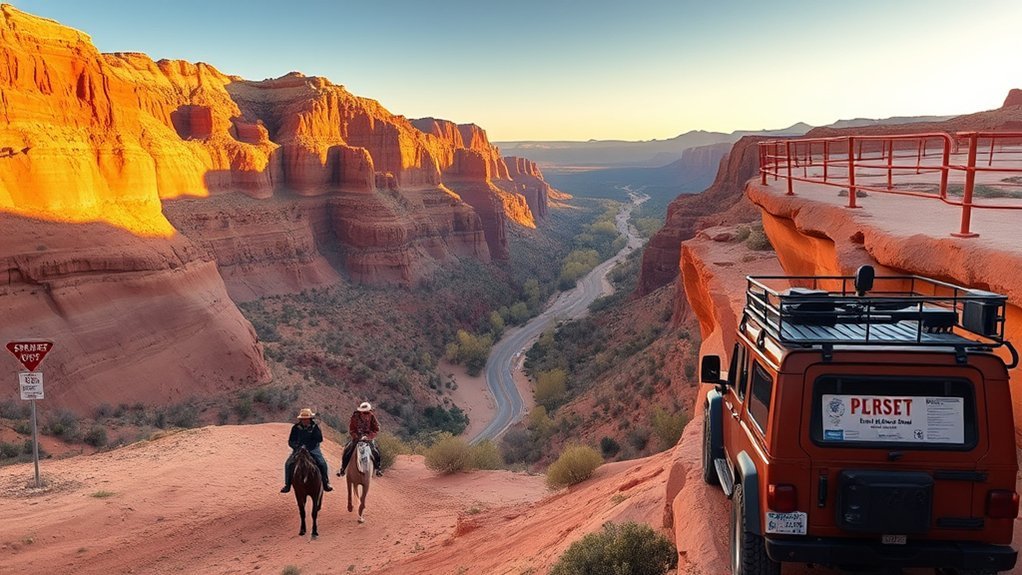
Because most of Canyon de Chelly is Navajo land and sacred, you’ll need an authorized Navajo guide to enter the canyon, and you’ll also pay an $8 per-person permit on top of tour fees that typically run between $70 and $350 depending on the format and length. You must follow access rules: guided tour only for canyon floor visits, Book a tour in advance through Thunderbird Lodge or local Navajo services, and respect cultural sites.
- Guided tour formats: 4WD, hiking, horseback — choose based on mobility and interest.
- Permits cost $8 per person; tour fees vary with duration and vehicle.
- Authorized Navajo guides lead and interpret sites, protecting sacred areas.
- White House Trail is closed indefinitely, limiting self-guided options.
Where to Stay and Eat
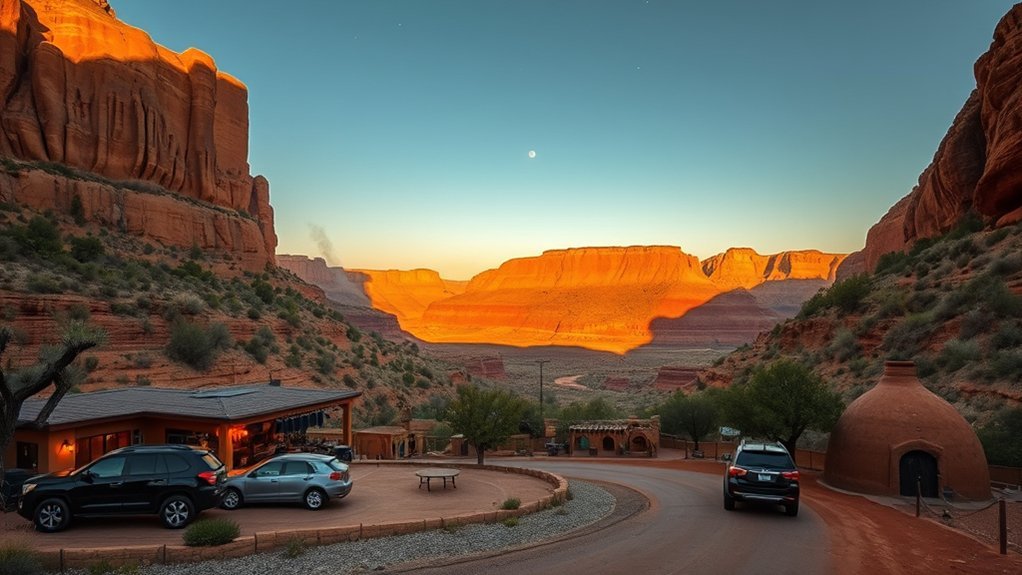
After you’ve arranged your guided tour and permits, choose lodging and meal plans that match the park’s limited services and your schedule. Within Canyon de Chelly the Thunderbird Lodge is the only lodging; it’s basic but convenient, and its cafeteria serves breakfast, lunch, and dinner for about $10–$15. Book well in advance, especially April–October, because availability is scarce. Four miles from the park entrance, Best Western Canyon de Chelly offers more traditional rooms and friendly service; its Junction Restaurant features local Navajo cuisine if you want a fuller sit-down meal. Chinle has additional dining options, but quality varies, so plan meals ahead and pack snacks or water since there are no vendors inside the monument.
Tips for Respectful and Safe Visiting
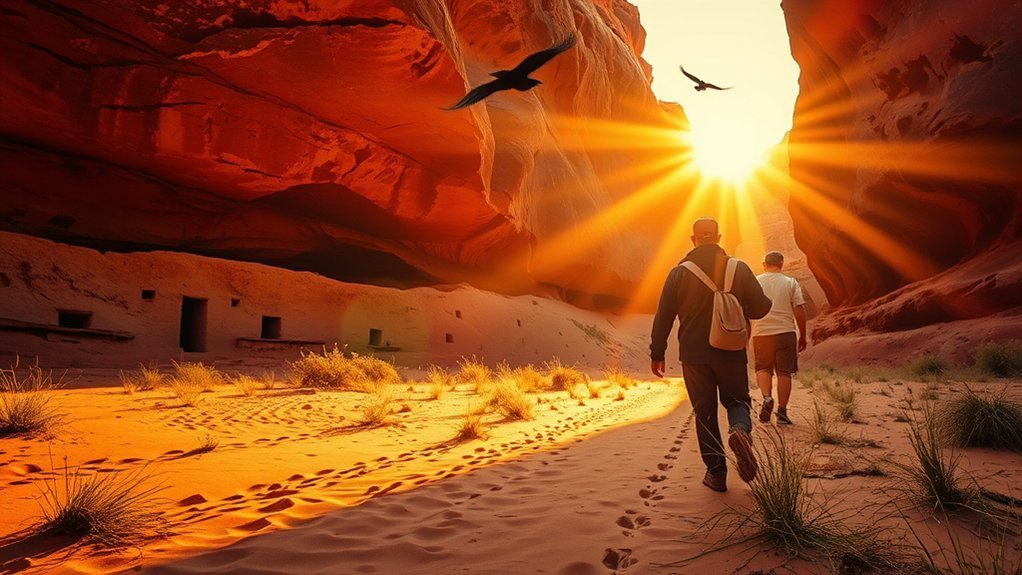
When you visit Canyon de Chelly, treat it as both a living community and a fragile landscape: respect Navajo homes and land, stay on designated trails, and follow park rules so you don’t disturb cultural sites or sensitive habitat. You’ll practice respectful visiting by following park regulations, hiring an authorized Navajo guide for canyon access, and removing all trash—there are no vendors for food or drink. Watch children near unguarded ledges and keep to designated paths to protect fragile plants and archaeological features. Remember the Navajo Nation’s sovereignty and customs; ask before photographing people or private property. Your choices keep the canyon intact and honor the people who live there—leave no trace, stay safe, and support local guides.
Frequently Asked Questions
Do You Need a Guide for Canyon De Chelly?
Yes—you need an authorized Navajo guide to enter the canyon; guided tours offer safety tips, cultural significance, local wildlife insights, photography opportunities, and help traversing trails, while self guided exploration’s limited to rim drives only.
What Is the Best Time of Year to Visit Canyon De Chelly?
Think summer’s best: you’ll enjoy June–August for warm weather patterns, peak seasonal activities, abundant wildlife sightings, top photography tips, cultural events, accessible hiking trails and visitor accommodations—plan smart to avoid crowds and midday heat for richer experiences.
How Much Does It Cost to Go to the Canyon De Chelly National Monument?
Entrance is free, but guided tours cost $70–$350 (plus an $8 permit); parking options vary; camping availability and permits may have fees; visit the visitor center for seasonal discounts, local attractions, and booking details.
What Is the Best Overlook in Canyon De Chelly?
Spider Rock Overlook is the best overlook; you’ll find best viewpoints for scenic photography, dramatic sunset views, nearby hiking trails, noted local flora, rich cultural history, and basic visitor amenities that enhance your memorable visit.
Conclusion
You’ll leave Canyon de Chelly with a deeper appreciation for its landscapes and Navajo heritage, and you’ll know how to plan for weather, permits, and respectful access. Stick to guided routes when needed, pack water and layers, and support local guides and eateries to keep benefits in the community. Take your time at overlooks and trails—you’ll get more out of the trip if you slow down and let the canyon work its magic, so don’t rush it.

